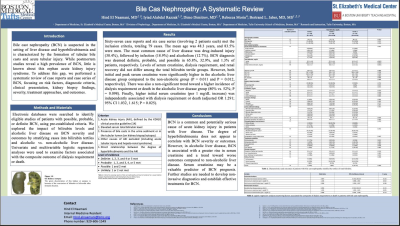Monday Poster Session
Category: Liver
P2943 - Bile Cast Nephropathy: A Systematic Review
Monday, October 28, 2024
10:30 AM - 4:00 PM ET
Location: Exhibit Hall E

Has Audio

Hind El Naamani, MD
St. Elizabeth's Medical Center, Boston University School of Medicine
Boston, MA
Presenting Author(s)
Hind El Naamani, MD1, Iyiad Alabdul Razzak, MD2, Dimo Dimitrov, MD1
1St. Elizabeth's Medical Center, Boston University School of Medicine, Boston, MA; 2St. Elizabeth's Medical Center, Boston University School of Medicine, Brighton, MA
Introduction: Bile cast nephropathy (BCN) occurs in various forms of liver failure, with autopsy studies indicating a prevalence of up to 55%. Despite this, BCN is frequently unrecognized due to uncertainties about its clinical impact, prognostic value, and management strategies. To address this gap, we conducted a systematic review of case reports, case series, and cohort studies to examine the clinical characteristics and outcomes of patients with BCN.
Methods: We searched electronic databases for eligible studies on BCN published from January 1, 1980, to October 31, 2023. BCN diagnosis certainty was classified as possible, probable, and definite based on pre-determined criteria. Case reports and case series were included, with analyses stratified by initial total bilirubin tertiles and the cause of cholestatic liver disease (alcohol- vs. nonalcohol-related). The Mann-Whitney U test and Kruskal-Wallis test were used for continuous variables, and the Chi square test for categorical variables.
Results: 67 case reports and 6 case series, met the inclusion criteria, totaling 79 cases. Mean age was 48.3 years old, and 83.5% were men. The most common cause of cholestatic liver disease was drug-induced injury (30.4%), infection (19.0%), and alcohol use (12.7%). Mean initial total bilirubin was 30.3 mg/dL. The diagnosis of BCN was deemed definite in 65.8%, probable in 32.9%, and possible in 1.3% of patients. 40 (50.6%) patients required dialysis. Follow-up data on kidney function were available for 73 patients, with complete recovery in 30 (41.1%) patients and partial recovery in 29 (39.7%) patients. Of the remainder, 8 (11%) patients remained dialysis-dependent or underwent kidney transplantation, and 6 (8%) died. There was a nonsignificant trend towards higher initial serum creatinine in the higher total bilirubin tertile group (p=0.07). There were otherwise no significant differences in other kidney injury related markers across the total bilirubin tertile groups. Patients with alcohol-related liver disease exhibited higher initial (p=0.01) and peak (p=0.01) serum creatinine, lower serum albumin (p=0.05), and higher INR (p=0.01).
Discussion: In patients with acute kidney injury due to BCN, serum creatinine is higher in those with alcohol-related cholestatic liver disease and higher total bilirubin levels, potentially indicating bile acid-associated nephrotoxicity. Further studies are needed to explore the role of albumin dialysis in removing bilirubin and bile acids in BCN patients.
Note: The table for this abstract can be viewed in the ePoster Gallery section of the ACG 2024 ePoster Site or in The American Journal of Gastroenterology's abstract supplement issue, both of which will be available starting October 27, 2024.
Disclosures:
Hind El Naamani, MD1, Iyiad Alabdul Razzak, MD2, Dimo Dimitrov, MD1. P2943 - Bile Cast Nephropathy: A Systematic Review, ACG 2024 Annual Scientific Meeting Abstracts. Philadelphia, PA: American College of Gastroenterology.
1St. Elizabeth's Medical Center, Boston University School of Medicine, Boston, MA; 2St. Elizabeth's Medical Center, Boston University School of Medicine, Brighton, MA
Introduction: Bile cast nephropathy (BCN) occurs in various forms of liver failure, with autopsy studies indicating a prevalence of up to 55%. Despite this, BCN is frequently unrecognized due to uncertainties about its clinical impact, prognostic value, and management strategies. To address this gap, we conducted a systematic review of case reports, case series, and cohort studies to examine the clinical characteristics and outcomes of patients with BCN.
Methods: We searched electronic databases for eligible studies on BCN published from January 1, 1980, to October 31, 2023. BCN diagnosis certainty was classified as possible, probable, and definite based on pre-determined criteria. Case reports and case series were included, with analyses stratified by initial total bilirubin tertiles and the cause of cholestatic liver disease (alcohol- vs. nonalcohol-related). The Mann-Whitney U test and Kruskal-Wallis test were used for continuous variables, and the Chi square test for categorical variables.
Results: 67 case reports and 6 case series, met the inclusion criteria, totaling 79 cases. Mean age was 48.3 years old, and 83.5% were men. The most common cause of cholestatic liver disease was drug-induced injury (30.4%), infection (19.0%), and alcohol use (12.7%). Mean initial total bilirubin was 30.3 mg/dL. The diagnosis of BCN was deemed definite in 65.8%, probable in 32.9%, and possible in 1.3% of patients. 40 (50.6%) patients required dialysis. Follow-up data on kidney function were available for 73 patients, with complete recovery in 30 (41.1%) patients and partial recovery in 29 (39.7%) patients. Of the remainder, 8 (11%) patients remained dialysis-dependent or underwent kidney transplantation, and 6 (8%) died. There was a nonsignificant trend towards higher initial serum creatinine in the higher total bilirubin tertile group (p=0.07). There were otherwise no significant differences in other kidney injury related markers across the total bilirubin tertile groups. Patients with alcohol-related liver disease exhibited higher initial (p=0.01) and peak (p=0.01) serum creatinine, lower serum albumin (p=0.05), and higher INR (p=0.01).
Discussion: In patients with acute kidney injury due to BCN, serum creatinine is higher in those with alcohol-related cholestatic liver disease and higher total bilirubin levels, potentially indicating bile acid-associated nephrotoxicity. Further studies are needed to explore the role of albumin dialysis in removing bilirubin and bile acids in BCN patients.
Note: The table for this abstract can be viewed in the ePoster Gallery section of the ACG 2024 ePoster Site or in The American Journal of Gastroenterology's abstract supplement issue, both of which will be available starting October 27, 2024.
Disclosures:
Hind El Naamani indicated no relevant financial relationships.
Iyiad Alabdul Razzak indicated no relevant financial relationships.
Dimo Dimitrov indicated no relevant financial relationships.
Hind El Naamani, MD1, Iyiad Alabdul Razzak, MD2, Dimo Dimitrov, MD1. P2943 - Bile Cast Nephropathy: A Systematic Review, ACG 2024 Annual Scientific Meeting Abstracts. Philadelphia, PA: American College of Gastroenterology.
